Abstract
OBJECTIVES--It has been shown previously that hyaluronic acid (HA) has an analgesic action on bradykinin induced pain in the knee joints of rats. This study further clarifies the effects of the molecular weight of HA and its mechanism of action in the same model using HA of molecular weight 800 to 2.3 x 10(6) daltons and a bradykinin antagonist. METHODS--Bradykinin and the test HA preparations were given to rats by intra-articular injection, and the severity of pain was evaluated by a change in the walking behaviour. RESULTS--HA with a molecular weight greater than 40 kilodaltons produces analgesic effects with a simultaneous or earlier injection. The ID50 values of HA with molecular weight 40, 310, 860, and 2300 kilodaltons were greater than 2.5, 0.6, 0.07, and 0.06 mg/joint respectively. The duration of the analgesic effect of 860 and 2300 kilodalton HA was 72 hours at 10 mg/ml, whereas that of 310 kilodalton HA was short, being undetectable after 24 hours. The analgesic action of HA of 860 kilodaltons was not changed by pretreatment with four saccharide HA and inhibited by pretreatment with HA larger than six to eight saccharides, capable of binding to HA receptors. Further, HA did not interfere with the analgesic action of the bradykinin antagonist, indicating that HA does not directly bind with bradykinin receptors. CONCLUSIONS--HA with a molecular weight of greater than 40 kilodaltons produced an analgesic effect, and HA of 860 and 2300 kilodaltons produced high and long-lasting analgesia. These effects of HA appear to be caused by the interaction between HA and HA receptors.
Full text
PDF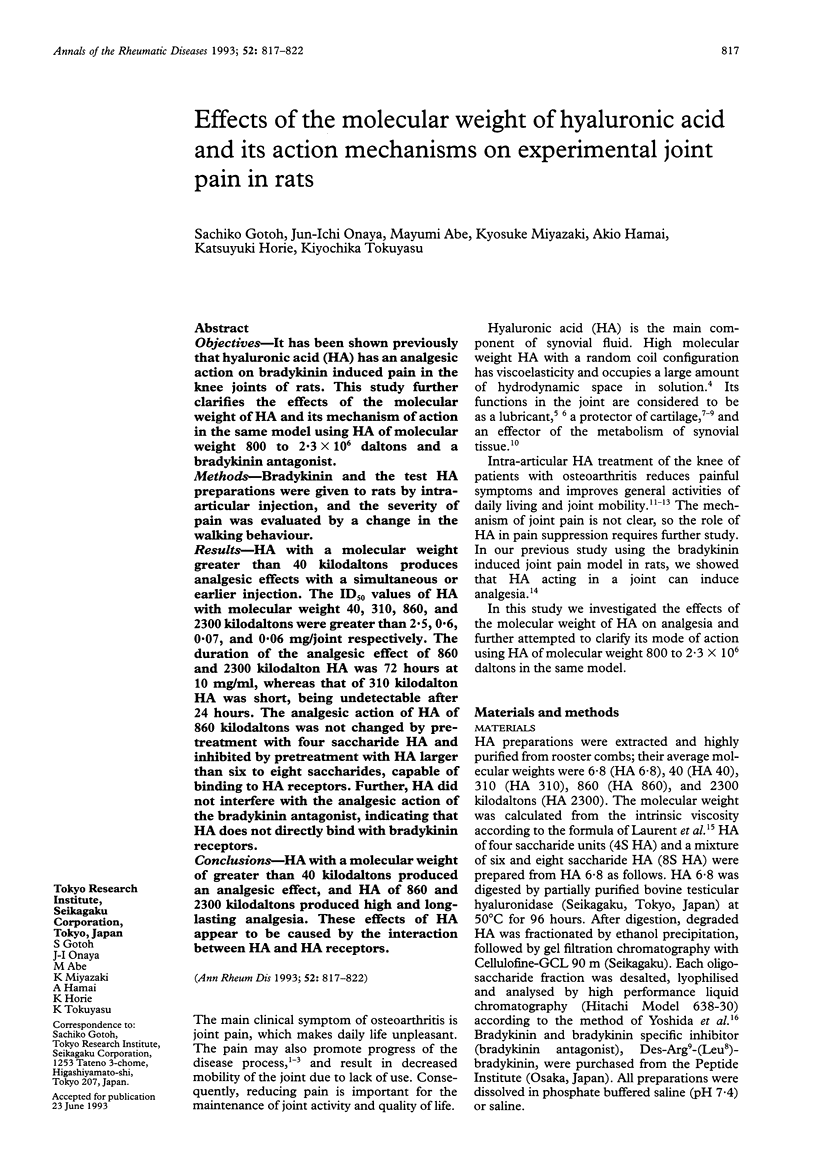
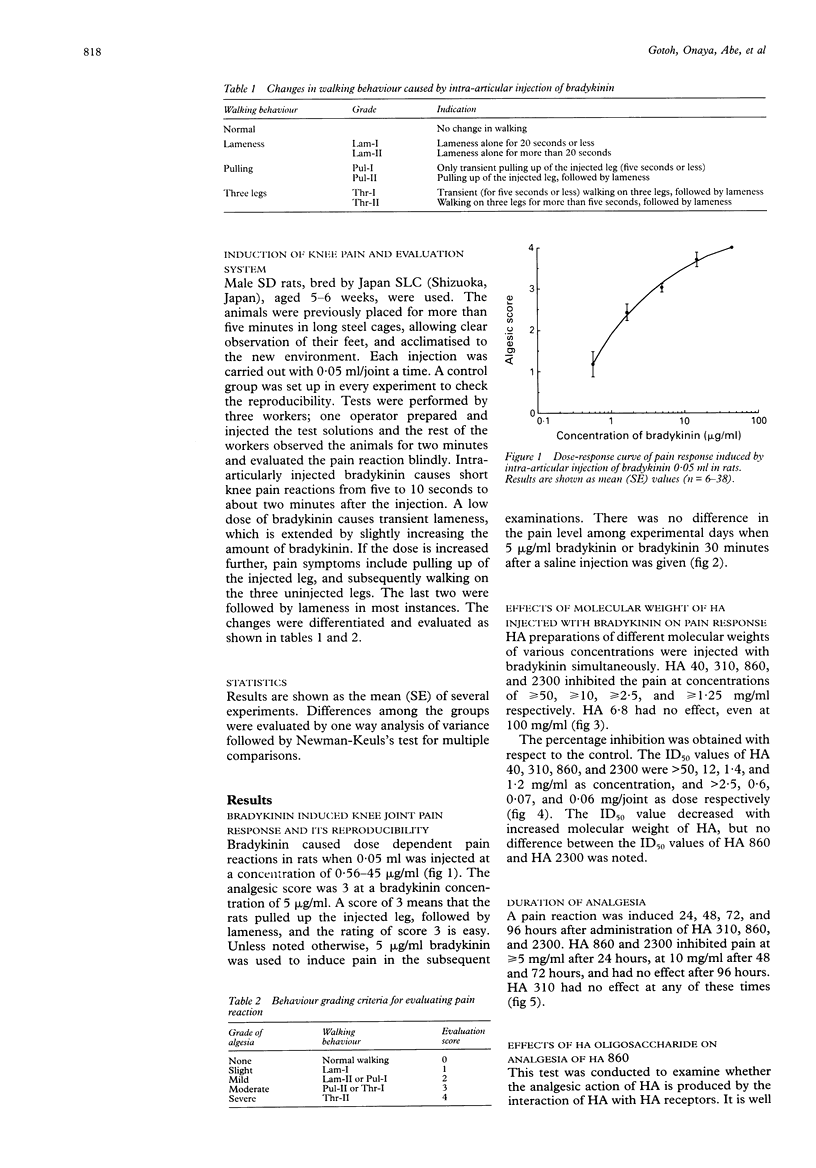
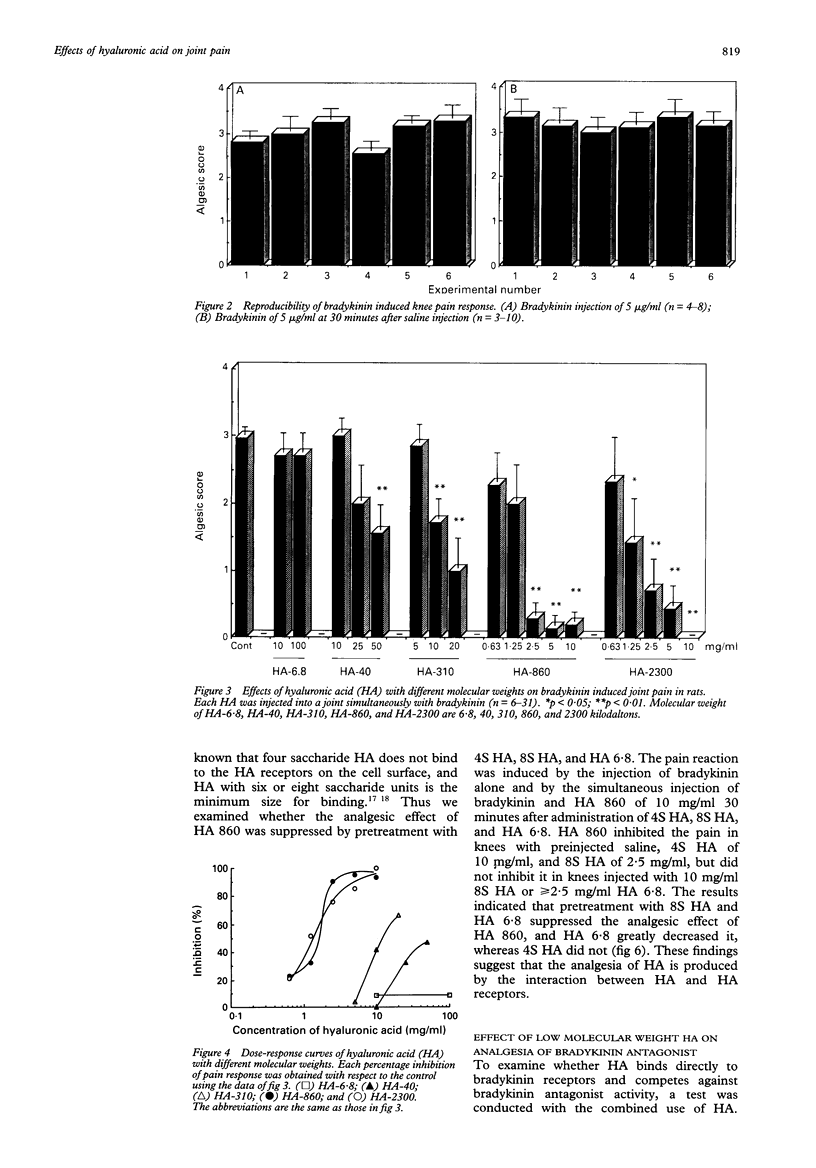
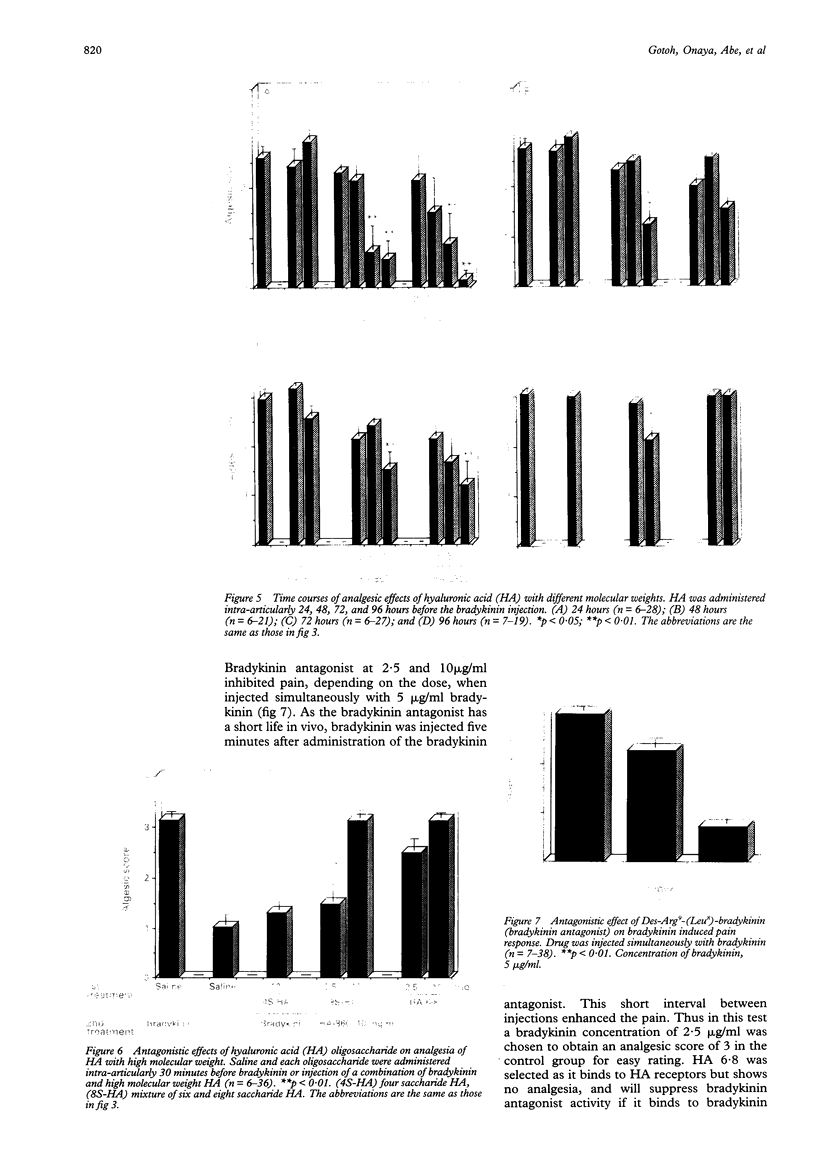
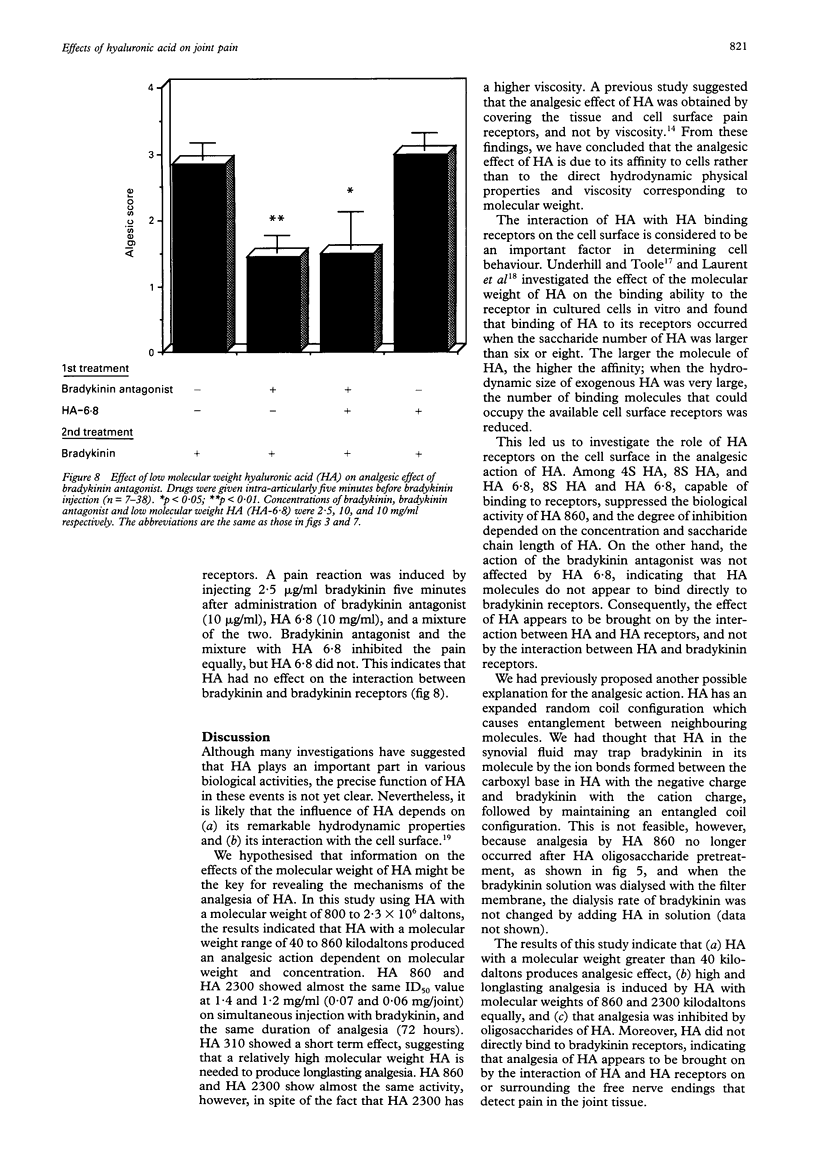
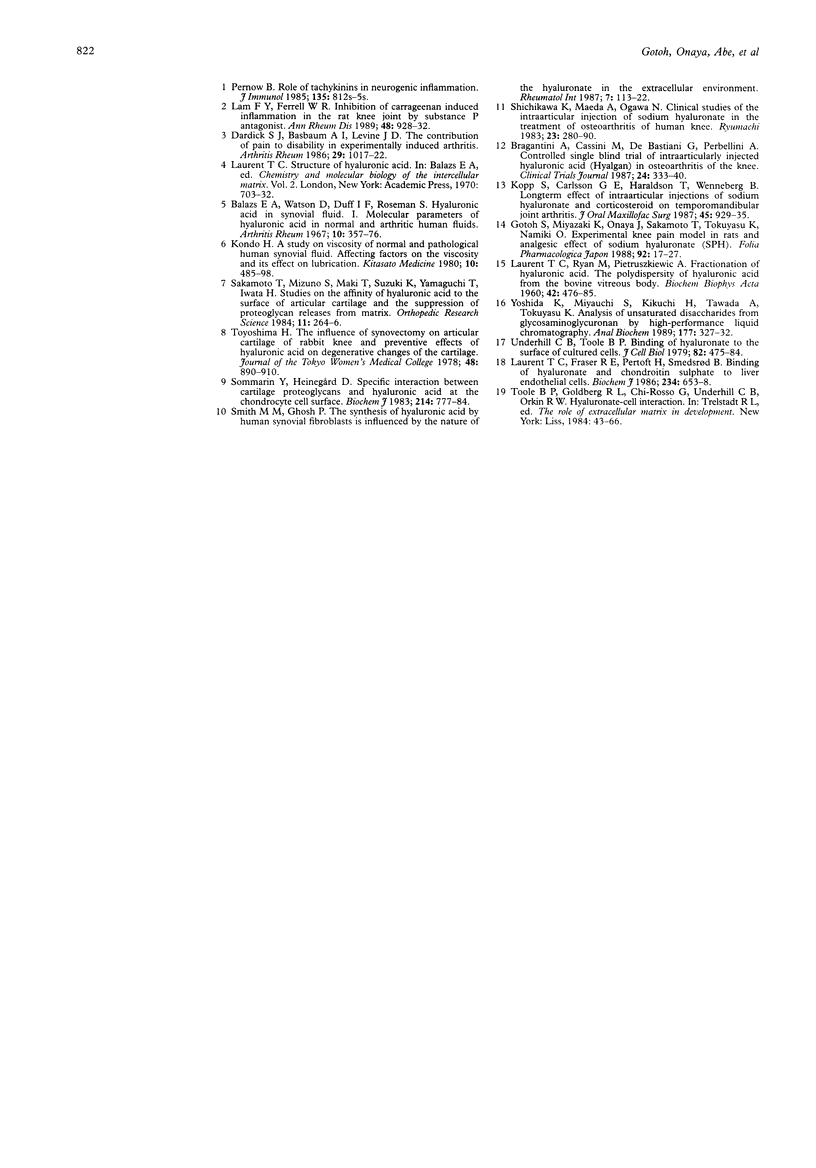
Images in this article
Selected References
These references are in PubMed. This may not be the complete list of references from this article.
- Dardick S. J., Basbaum A. I., Levine J. D. The contribution of pain to disability in experimentally induced arthritis. Arthritis Rheum. 1986 Aug;29(8):1017–1022. doi: 10.1002/art.1780290811. [DOI] [PubMed] [Google Scholar]
- Gotoh S., Miyazaki K., Onaya J., Sakamoto T., Tokuyasu K., Namiki O. [Experimental knee pain model in rats and analgesic effect of sodium hyaluronate (SPH)]. Nihon Yakurigaku Zasshi. 1988 Jul;92(1):17–27. doi: 10.1254/fpj.92.17. [DOI] [PubMed] [Google Scholar]
- Kopp S., Carlsson G. E., Haraldson T., Wenneberg B. Long-term effect of intra-articular injections of sodium hyaluronate and corticosteroid on temporomandibular joint arthritis. J Oral Maxillofac Surg. 1987 Nov;45(11):929–935. doi: 10.1016/0278-2391(87)90443-5. [DOI] [PubMed] [Google Scholar]
- Lam F. Y., Ferrell W. R. Inhibition of carrageenan induced inflammation in the rat knee joint by substance P antagonist. Ann Rheum Dis. 1989 Nov;48(11):928–932. doi: 10.1136/ard.48.11.928. [DOI] [PMC free article] [PubMed] [Google Scholar]
- Laurent T. C., Fraser J. R., Pertoft H., Smedsrød B. Binding of hyaluronate and chondroitin sulphate to liver endothelial cells. Biochem J. 1986 Mar 15;234(3):653–658. doi: 10.1042/bj2340653. [DOI] [PMC free article] [PubMed] [Google Scholar]
- Pernow B. Role of tachykinins in neurogenic inflammation. J Immunol. 1985 Aug;135(2 Suppl):812s–815s. [PubMed] [Google Scholar]
- Shichikawa K., Maeda A., Ogawa N. [Clinical evaluation of sodium hyaluronate in the treatment of osteoarthritis of the knee]. Ryumachi. 1983 Aug;23(4):280–290. [PubMed] [Google Scholar]
- Smith M. M., Ghosh P. The synthesis of hyaluronic acid by human synovial fibroblasts is influenced by the nature of the hyaluronate in the extracellular environment. Rheumatol Int. 1987;7(3):113–122. doi: 10.1007/BF00270463. [DOI] [PubMed] [Google Scholar]
- Sommarin Y., Heinegård D. Specific interaction between cartilage proteoglycans and hyaluronic acid at the chondrocyte cell surface. Biochem J. 1983 Sep 15;214(3):777–784. doi: 10.1042/bj2140777. [DOI] [PMC free article] [PubMed] [Google Scholar]
- Underhill C. B., Toole B. P. Binding of hyaluronate to the surface of cultured cells. J Cell Biol. 1979 Aug;82(2):475–484. doi: 10.1083/jcb.82.2.475. [DOI] [PMC free article] [PubMed] [Google Scholar]
- Yoshida K., Miyauchi S., Kikuchi H., Tawada A., Tokuyasu K. Analysis of unsaturated disaccharides from glycosaminoglycuronan by high-performance liquid chromatography. Anal Biochem. 1989 Mar;177(2):327–332. doi: 10.1016/0003-2697(89)90061-4. [DOI] [PubMed] [Google Scholar]








